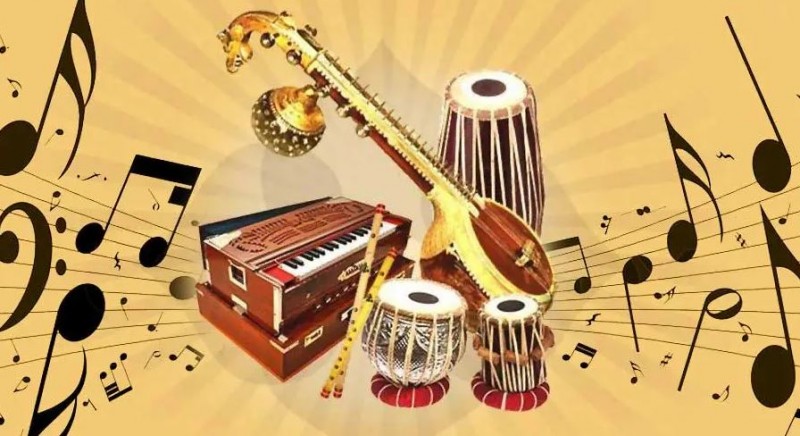
Indian classical music, a treasure trove of rich melodies and intricate rhythms, is among the world's oldest and most revered musical traditions. Rooted in ancient scriptures, its history spans several millennia, captivating listeners with its emotive power and spiritual depth. Indian classical music is the classical music of the Indian subcontinent. It is generally described using terms like Marg Sangeet and Shastriya Sangeet. It has two major traditions: the North Indian classical music known as Hindustani and the South Indian expression known as Carnatic. In this article, we embark on a comprehensive journey through the history of Indian classical music, delving into its origins, evolution, prominent schools, legendary musicians, and enduring impact on Indian culture and society.
Origins and Ancient Foundations
The origins of Indian classical music can be traced back to the sacred Vedic chants and rituals dating back more than 3,000 years. These chants, known as Samaveda, formed the basis of the ancient musical system and were an essential part of religious ceremonies. The concept of raga (melody) and tala (rhythm) emerged during this period, shaping the foundation of Indian classical music.
The Golden Age: Emergence of the Two Major Traditions
Around 500 BCE to 500 CE, Indian classical music experienced a significant evolution during the reign of the Maurya and Gupta empires. It was during this period that two distinct traditions of Indian classical music emerged – Hindustani and Carnatic music.
a. Hindustani Music: The advent of Persian and Central Asian influences, especially with the arrival of the Mughals, played a pivotal role in shaping Hindustani music. Dhrupad and Dhamar were the primary vocal forms during this time, and the sitar and sarod emerged as prominent instruments. Notable musicians like Tansen and Baiju Bawra left an indelible mark on this tradition. The Hindustani music style is mainly found in North India, Pakistan, and Bangladesh. It exists in four major forms: Dhrupad, Khyal (or Khayal), Tarana, and the semi-classical Thumri. Dhrupad is ancient, Khyal evolved from it, and Thumri evolved from Khyal. There are three major schools of Thumri: Lucknow gharana, Banaras gharana and Punjabi gharana. These weave in folk music innovations.
b. Carnatic Music: Flourishing in the southern regions of India, Carnatic music evolved from the ancient Tamil music traditions. It retained a strong connection with the temples and was characterized by intricate rhythmic patterns and expressive vocals. Pioneers like Purandara Dasa and Tyagaraja contributed significantly to Carnatic music's growth. Carnatic music, from South India, tends to be more rhythmically intensive and structured than Hindustani music. Examples of this are the logical classification of ragas into melakartas and the use of fixed compositions similar to Western classical music.
Medieval Period: Flourishing Under Patronage
During the medieval period, Indian classical music received significant patronage from various kingdoms and princely states. Musicians found themselves at the courts of kings and nobles, fostering a rich exchange of musical ideas. Notable musicians such as Swami Haridas, Baiju Bawra, and Amir Khusrau enriched the musical landscape during this era.
The Mughal Era and North-South Synergy
The Mughal era (16th to 19th century) marked a period of flourishing creativity and cultural fusion. The Mughal rulers' patronage resulted in a remarkable synthesis of Indian and Persian musical traditions. Iconic musicians like Tansen and Miyan Tansen emerged as legendary figures, showcasing the beauty of Indian classical music to the Mughal courts.
Decline and Revival: British Colonial Influence
The 18th and 19th centuries witnessed a decline in traditional patronage, primarily due to British colonial rule. Western music and entertainment began to gain popularity, leading to a temporary setback for Indian classical music. However, stalwarts like Pandit Vishnu Digambar Paluskar and Pandit Vishnu Narayan Bhatkhande played a crucial role in the revival of classical music, establishing music schools and promoting the Guru-Shishya (teacher-student) tradition.
20th-Century Renaissance and Modern Innovations
The 20th century witnessed a renaissance of Indian classical music, with visionary musicians like Pandit Ravi Shankar and Ustad Allauddin Khan bringing the genre to international prominence. Their collaborations with Western artists and fusion experiments helped popularize Indian classical music worldwide. Additionally, the introduction of recording technology and mass media further expanded its reach and accessibility.
Diverse Gharanas and Artistic Lineages
Indian classical music is deeply rooted in the tradition of gharanas – distinct schools or lineages of music that pass down knowledge through generations. Each Gharana has its unique style, repertoire, and approach to ragas and talas. We explore some of the most renowned arenas, such as the Kirana, Gwalior, Rampur-Sahaswan, and Patiala, among others, and their contributions to the musical landscape.
The Maestros and Legends
Throughout history, Indian classical music has been blessed with an array of legendary musicians who have left an everlasting impact on the art form. From the enchanting vocalism of Ustad Bade Ghulam Ali Khan and Lata Mangeshkar to the mesmerizing sitar performances of Pandit Ravi Shankar and Ustad Vilayat Khan, we delve into the lives and contributions of these maestros.
Indian Classical Music in Contemporary Times
In contemporary times, Indian classical music continues to thrive with a new generation of talented artists and musicians. The rise of music festivals, dedicated educational institutions, and online platforms has rejuvenated interest in this timeless art form. Furthermore, collaborations with other genres, such as jazz, rock, and electronic music, are pushing the boundaries of traditional Indian classical music, creating exciting new expressions.
Indian classical music has stood the test of time, weaving its melodious tapestry through the ages. Its profound impact on Indian culture, spirituality, and artistic expression is immeasurable. As we gaze upon its storied history, we are reminded of its timeless relevance and how it continues to inspire generations, fostering a cultural legacy that resonates across the globe. The allure of Indian classical music lies in its ability to transcend barriers, harmonizing hearts and souls in a celebration of human creativity and spirituality.
Unity in Diversity: The Cultural Extravaganza of Modern Indian Celebrations
Crafting Stories: The Art of Indian Handicrafts and Textiles
Cities to travel for music lovers